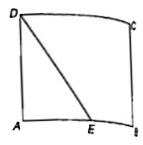ABCD is square of side 4 cm. If E is point in the interior of the square such that ΔCED is equilateral, then find the area of ΔACE in cm2
Area of ΔCED(A1)=√34∗4∗4=4√3cm2
Area of ΔAED(A2)=12∗AD∗ED∗sin∠ADE
Here, AD=DE=4cm
∠ADE=90∘−∠CDE=90∘−60∘=30∘
∴ Area of ΔAED(A2)=12∗4∗4∗sin30∘=8∗12=4cm2
Area of ΔADC(A3)=12∗4∗4=8cm2
∴ Area of ΔAEC(A)=A1+A2−A3
⇒A=4√3+4−8=4√3−4=4(√3−1)cm2
So, area of ΔACE is 4(√3−1)cm2.
Similar Questions
ABCD is a square , E is a point on AB such that BE=17 cm. The area of triangle ADE is 84 cm2 . What is the area of square ?

View SolutionIn the figure ABCD is trapezium. Diagonals meet at the point E. Area of triangle CED = 16 cm^2 , Area of triangle AED is 36 cm^2 . Find the area of triangle AED , triangle BEC
View SolutionThe difference between the area of a square and that of an equilateral triangle on the same base is 1/4 cm2. What is the length of side of triangle ?
View SolutionA square is drawn on the altitude of an equilateral triangle of side 4 cm.
a) What is the altitude of the triangle?
b) What is the area and perimeter of the square?
View SolutionThe difference between the area of a square and that of an equilateral triangle on the same base is 1/4 cm2. What is the length of side of triangle ?
View SolutionThe difference between the area of a square and that of an equilateral triangle on the same base is 1/4 cm2. What is the length of side of triangle ?
View SolutionABCD is a square. Draw an equilateral triangle PBC on side BC considering BC is a base and an equilateral triangle QAC on diagonal AC considering AC is a base. Find the value of ("Area of " Delta PBC)/("Area of " Delta QAC) .
View SolutionThe difference between the area of a square and that of an equilateral triangle on the same base is 14cm2 What is the length of side of triangle ?
View Solution